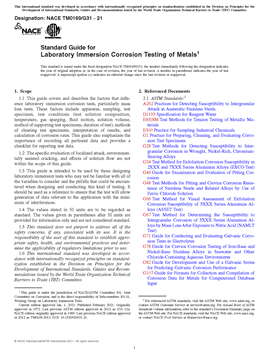Search
Test Method
View as
Sort by
Display
per page
Methodology for Coated Infrastructure Inspection by Mobile Potentiostat
Product Number:
41215-912-SG
Publication Date:
2015
$20.00
Modern Corrosion Testing: From Traditional Salt Spray Test to the Latest Innovative Methods with Advanced Environmental Controls
Product Number:
41216-962-SG
Publication Date:
2016
$20.00
Moisture Test methods, Comparisons, Commonalities and Dissimilarities
Product Number:
41215-929-SG
Publication Date:
2015
$20.00
NACE Publication 1D182-2017-SG, Wheel Test Method Used for Evaluation of Film-Persistent Corrosion Inhibitors for Oilfield Applications (2017 Edition)
Product Number:
24007-SG
ISBN:
1-57590-390-3
Publication Date:
2017
$109.00
NACE TM0169-2021/ASTM G31-21, Standard Guide for Laboratory Immersion Corrosion Testing of Metals
Product Number:
21200-SG
Publication Date:
2021
$109.00
NACE TM0174-2022, Laboratory Test Methods for the Evaluation of Protective Coatings and Lining Materials on Metallic Substrates in Immersion Service
Product Number:
NACE TM0174-2022
Publication Date:
2022
$109.00
NACE TM0177-2005, Laboratory Testing of Metals for Resistance to Sulfide Stress Cracking and Stress Corrosion Cracking in H2S Environments
Product Number:
NACE TM0177-2005
Publication Date:
2005
$179.00
NACE TM0177-2024, Laboratory Testing of Metals for Resistance to Sulfide Stress Cracking and Stress Corrosion Cracking in H2S Environments
Product Number:
NACE TM0177-2024
Publication Date:
2024
$109.00
NACE TM0185-2024, Evaluation of Internal Plastic Coatings for Corrosion Control of Tubular Goods by Autoclave Testing
Product Number:
NACE TM0185-2024
Publication Date:
2024
$109.00
NACE TM0294-HD1994-SG Testing of Embeddable Anodes for Use in Cathodic Protection of Atmospherically Exposed Steel-Reinforced Concrete-HD1994
Product Number:
21225-HD1994
Publication Date:
1994
$179.00
NACE TM0316-2023, Four-Point Bend Testing of Materials for Oil and Gas Applications
Product Number:
NACE TM0316-2023
Publication Date:
2023
$109.00












